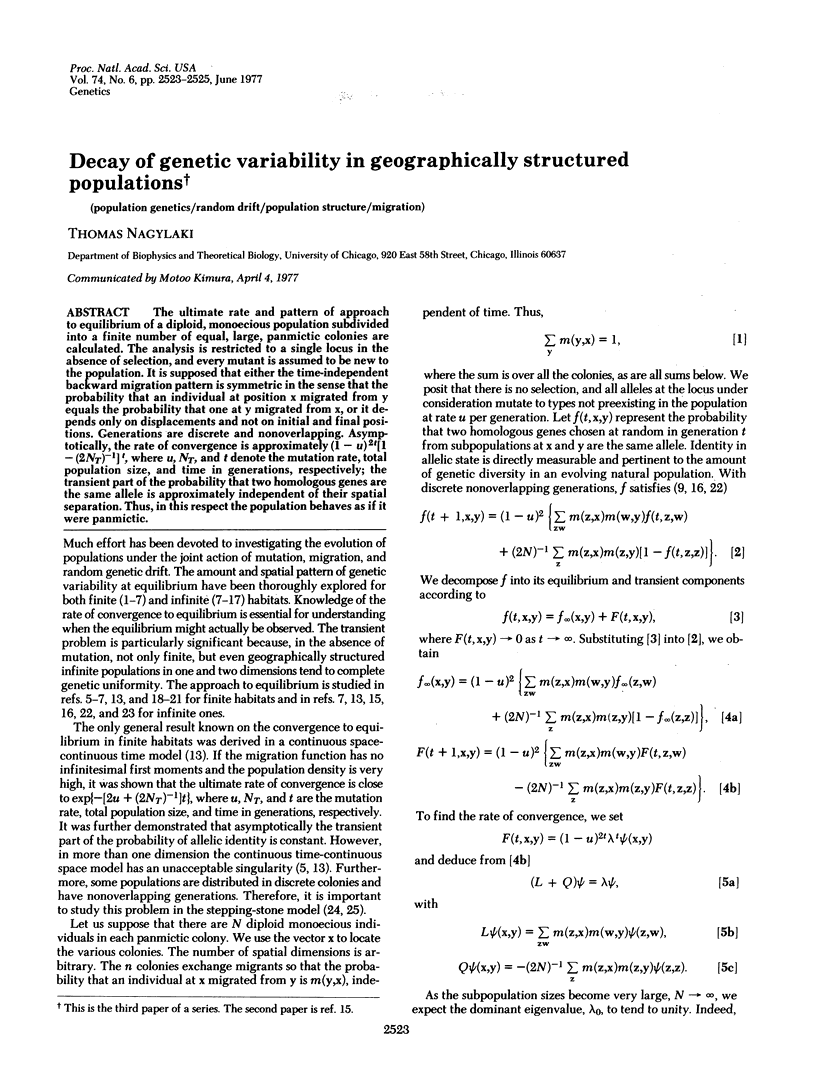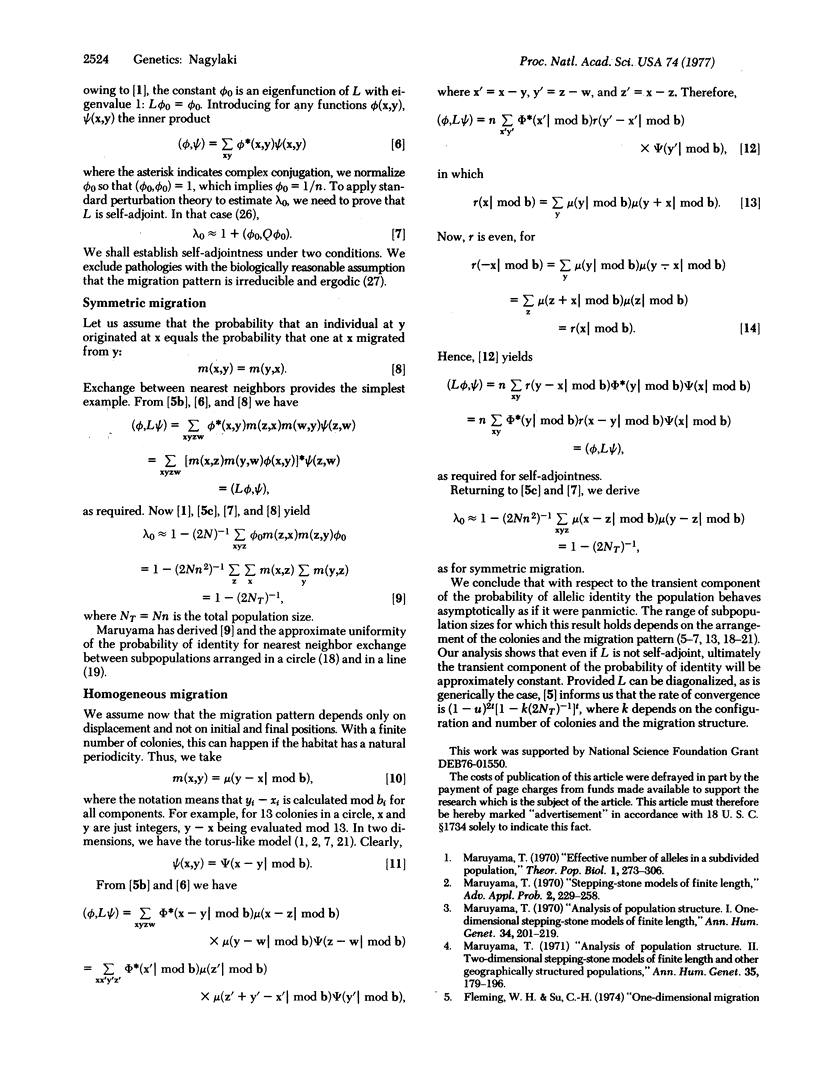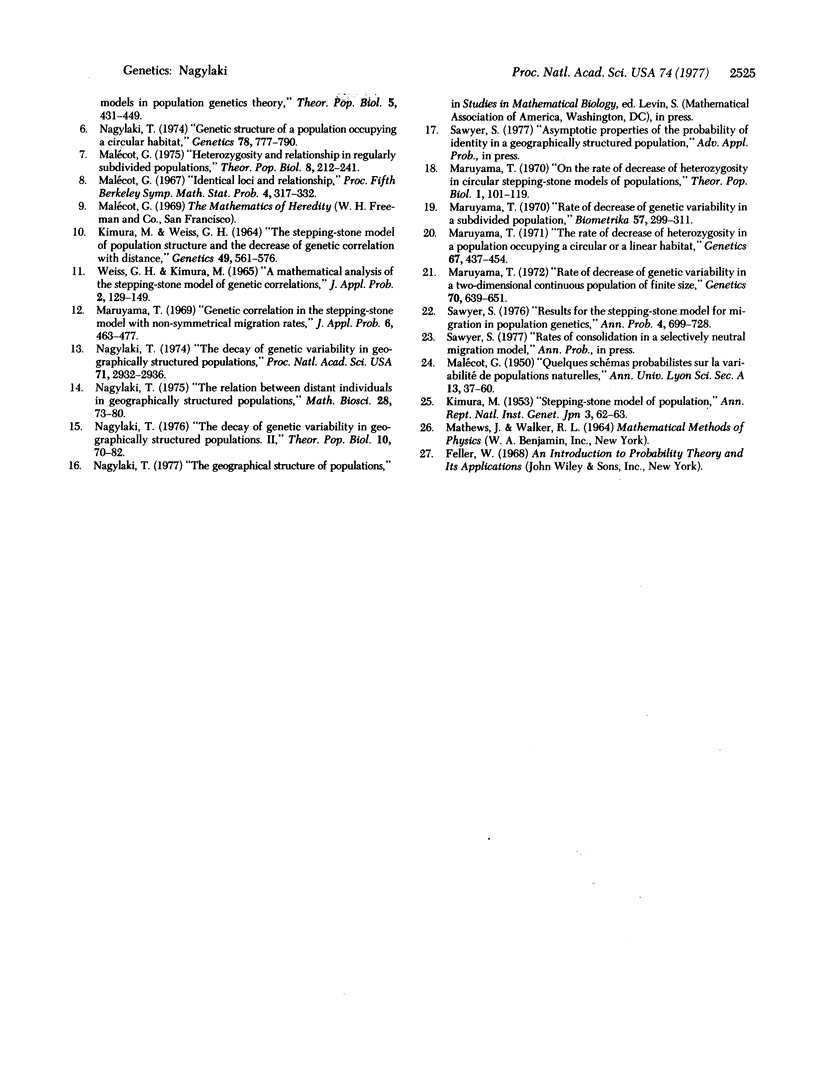Abstract
The ultimate rate and pattern of approach to equilibrium of a diploid, monoecious population subdivided into a finite number of equal, large, panmictic colonies are calculated. The analysis is restricted to a single locus in the absence of selection, and every mutant is assumed to be new to the population. It is supposed that either the time-independent backward migration pattern is symmetric in the sense that the probability that an individual at position x migrated from y equals the probability that one at y migrated from x, or it depends only on displacements and not on initial and final positions. Generations are discrete and nonoverlapping. Asymptotically, the rate of convergence is approximately (I-u)2t[I-(2NT)-1]t, where u, NT, and t denote the mutation rate, total population size, and time in generations, respectively; the transient part of the probability that two homologous genes are the same allele is approximately independent of their spatial separation. Thus, in this respect the population behaves as if it were panmictic.
Full text
PDF


Selected References
These references are in PubMed. This may not be the complete list of references from this article.
- Dooner H. K., Kermicle J. L. Structure of the R r tandem duplication in maize. Genetics. 1971 Mar;67(3):437–454. doi: 10.1093/genetics/67.3.437. [DOI] [PMC free article] [PubMed] [Google Scholar]
- Kimura M, Weiss G H. The Stepping Stone Model of Population Structure and the Decrease of Genetic Correlation with Distance. Genetics. 1964 Apr;49(4):561–576. doi: 10.1093/genetics/49.4.561. [DOI] [PMC free article] [PubMed] [Google Scholar]
- Malécot G. Heterozygosity and relationship in regularly subdivided populations. Theor Popul Biol. 1975 Oct;8(2):212–241. doi: 10.1016/0040-5809(75)90033-7. [DOI] [PubMed] [Google Scholar]
- Maruyama T. Analysis of population structure. I. One-dimensional stepping-stone models of finite length. Ann Hum Genet. 1970 Oct;34(2):201–219. doi: 10.1111/j.1469-1809.1970.tb00235.x. [DOI] [PubMed] [Google Scholar]
- Maruyama T. Analysis of population structure. II. Two-dimensional stepping stone models of finite length and other geographically structured populations. Ann Hum Genet. 1971 Oct;35(2):179–196. doi: 10.1111/j.1469-1809.1956.tb01391.x. [DOI] [PubMed] [Google Scholar]
- Maruyama T. Effective number of alleles in a subdivided population. Theor Popul Biol. 1970 Nov;1(3):273–306. doi: 10.1016/0040-5809(70)90047-x. [DOI] [PubMed] [Google Scholar]
- Maruyama T. On the rate of decrease of heterozygosity in circular stepping stone models of populations. Theor Popul Biol. 1970 May;1(1):101–119. doi: 10.1016/0040-5809(70)90044-4. [DOI] [PubMed] [Google Scholar]
- Maruyama T. Rate of decrease of genetic variability in a two-dimensional continuous population of finite size. Genetics. 1972 Apr;70(4):639–651. doi: 10.1093/genetics/70.4.639. [DOI] [PMC free article] [PubMed] [Google Scholar]
- Nagylaki T. Genetic structure of a population occupying a circular habitat. Genetics. 1974 Oct;78(2):777–790. doi: 10.1093/genetics/78.2.777. [DOI] [PMC free article] [PubMed] [Google Scholar]
- Nagylaki T. The decay of genetic variability in geographically structured populations. II. Theor Popul Biol. 1976 Aug;10(1):70–82. doi: 10.1016/0040-5809(76)90006-x. [DOI] [PubMed] [Google Scholar]
- Nagylaki T. The decay of genetic variability in geographically structured populations. Proc Natl Acad Sci U S A. 1974 Aug;71(8):2932–2936. doi: 10.1073/pnas.71.8.2932. [DOI] [PMC free article] [PubMed] [Google Scholar]


